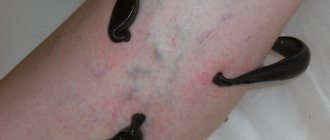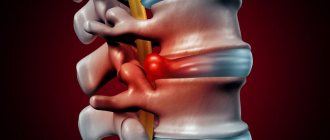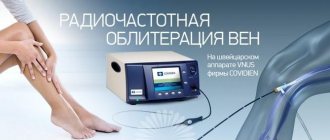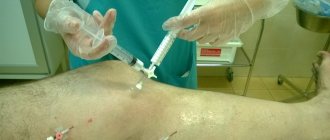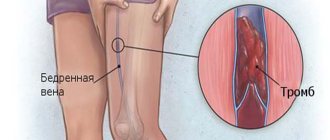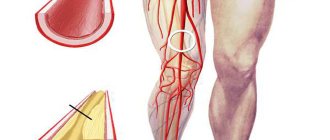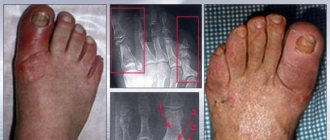History of the method of miniphlebectomy (microphlebectomy) of veins
The founder of the vein miniphlebectomy technique is considered to be Robert Müller, a Swiss dermatologist and phlebologist. Dr. Müller first used the miniphlebectomy method in the 1950s, as the doctor was not satisfied with the results of both scleroobliteration and surgical removal of individual venous vessels. Robert Mueller wanted an alternative method for radical vein removal, but without the side effect of large, conspicuous scars after classical operations. The miniphlebectomy method was presented by a Swiss doctor at the annual meeting of the French Society of Phlebology in the 60s of the last century after approximately 10 years of independent practical use. In subsequent years, the technology improved and developed, new manipulation techniques and more modern tools (hooks) appeared.
Professor Zoltan Varadi
The greatest contribution to this process was made by Zoltan Varadi, who seriously modified the methodology and gave it new vectors of development.
Miniphlebectomy (microphlebectomy) of veins - what is it?
Miniphlebectomy (microphlebectomy) of veins is a surgical operation to remove varicose veins using punctures or small incisions in the skin. Also, miniphlebectomy can be characterized as a radical intervention for the treatment of varicose veins with a very good cosmetic effect. Varicose veins are completely removed using miniphlebectomy.
Miniphlebectomy (microphlebectomy) of varicose veins
Small scars that form after manipulation are difficult to see with the naked eye. Using the miniphlebectomy method, almost any segments of veins located suprafascially can be removed.
Advantages of the method
This type of surgical intervention quickly gained popularity among patients and specialists. The main advantages of miniphlebectomy are:
- no need to stay in the hospital after the procedure;
- local anesthesia is used;
- instead of long incisions, punctures or micro-incisions are used;
- no severe pain;
- after the operation there is a good cosmetic effect;
- short rehabilitation period with no significant restrictions;
- It is possible to carry out the procedure at any age and with concomitant chronic diseases.
Types and methods of miniphlebectomy of veins
The differences in the application of the vein miniphlebectomy technique lie mainly in the use of different surgical hooks. The following hooks for miniphlebectomy are considered to be the most successful and best:
- Varadi.
- Muller.
- Eshu.
Varadi hooks for miniphlebectomy
Basic principles of the vein miniphlebectomy procedure
The procedure for miniphlebectomy of varicose veins is performed in the sterile conditions of a surgical operating room using special instruments: miniphlebectomy hooks and Mosquito clamps. Varicose veins are removed through punctures and micro-incisions of the skin.
Stages of miniphlebectomy according to Varadi
The miniphlebectomy operation is quite delicate, so the experience and manual skills of the specialists performing the procedure are of great importance.
Operation options
This method of treating varicose veins was invented by the Swedish dermatologist Muller in the 60s of the last century. Later, the methods of performing the operation were refined and updated by other specialists. Now the most effective option is miniphlebectomy using the Varadi technique, which was developed by the German surgeon Zlotan Varadi. It can be performed as an independent procedure or in conjunction with more complex operations for the treatment of varicose veins.
Operation options:
- Miniphlebectomy according to Müller. Enlarged varicose veins are removed through small punctures using special hooks. Perforating veins are ligated. After the procedure, the edges of the punctures are fixed with a special plaster; no stitches are required.
- Miniphlebectomy according to Varadi. Varicose nodes are also removed through punctures using Varadi hooks. When performing an operation using this technique, no defects remain on the skin.
Another way to perform the operation is with intraoperative scleroobliteration or sclerotherapy. The subcutaneous vessels are exposed to sclerosant - a special chemical composition that is injected in the form of foam into the dilated vein and glues it together.
Another option is laser miniphlebectomy. EVLT or endovasal laser coagulation of varicose veins is a modern method that involves laser exposure to the inner walls of an enlarged vein.
Indications for miniphlebectomy of the veins of the lower extremities
The main indication for miniphlebectomy of the veins of the lower extremities is the presence of varicose veins and nodes. Miniphlebectomy is a planned procedure indicated for varicose dilation of the tributaries of the main veins and the presence of reflux in them. Also, indications for miniphlebectomy may be complications of varicose veins:
- Recurrent thrombophlebitis.
- Bleeding from venous nodes.
- Trophic disorders associated with chronic venous insufficiency.
- Chronic venous edema.
- Skin hyperpigmentation.
- Trophic ulcer.
Indications and contraindications
The operation is prescribed for persons with varicose veins or nodes to remove dilated vessels in the intimate area, on the face, for thrombosis, as well as for the final stage of vein removal for thrombophlebitis after its treatment. The procedure can be performed in combination with other operations. Miniphlebectomy on its own is possible only in the initial stages of the pathology.
Contraindications for venous miniphlebectomy
A contraindication for miniphlebectomy may be the presence of local and concomitant severe systemic pathology.
- Infection and dermatitis in the intervention area. Before surgery, it is necessary to stop the inflammatory process.
- The presence of pronounced venous and (or) lymphatic edema in the surgical area. Edema should be eliminated or reduced to reduce the likelihood of postoperative complications.
- Severe cardiovascular pathology, lung disease, uncontrolled diabetes mellitus, disorders of the blood coagulation system or immune system. Before intervention, stabilization of the underlying disease is necessary.
- Pregnancy. Miniphlebectomy is delayed until at least 12 weeks after birth. During this period, a significant portion of varixes disappear on their own.
Miniphlebectomy - contraindications
The inability of the venous vessels of the lower extremities to cope with the outflow of blood causes their expansion, swelling and pain.
Negative changes in appearance and decreased functionality of the saphenous veins lead to the need for surgery.
The reverse flow of blood, which is observed with insufficiency of the venous valves, leads to the appearance of stagnation of blood in places where the vessel wall is weakened.
A blood clot forms there, a potentially fatal clot.
If it clogs a vein, it is preferable to remove it.
Miniphlebectomy is not performed if:
- the operation is hampered by the patient’s serious condition caused by other diseases;
- the patient has permanently or temporarily limited mobility;
- when checking the patency of deep veins, violations of their functions were revealed;
- the presence of severe diseases of the cardiovascular system - arterial hypertension, ischemic heart disease, chronic heart failure;
- decreased blood clotting rates;
- there are infectious diseases, especially accompanied by inflammation of the skin on the legs;
- the woman is pregnant or breastfeeding.
Maybe
Technique of vein miniphlebectomy procedure
Before the miniphlebectomy procedure, a detailed assessment of venous blood flow is required using duplex ultrasound scanning and the course of the operation is planned.
Mandatory ultrasound scanning of veins before miniphlebectomy
A very important aspect that affects the success of the operation is the preoperative marking of the target veins with a marker, which allows you to remove all pathological vessels in one procedure. Tumescent anesthesia, developed by Jeff Klein, is used for pain relief. A solution is used that includes low concentrations of anesthetics, which allows for more extensive interventions to be performed in a surgical setting.
Miniphlebectomy according to Varadi in Moscow
To make skin incisions at the Moscow Medical Center, 18 G needles are used. This helps minimize surgical trauma. Manipulation is carried out using special hooks. The most popular hooks among European phlebologists are Varadi, Muller, Ash, and Ramele hooks. In the practice of our center, the tools of all the authors listed above were used, but the Muller and Varady hooks showed themselves to be the best.
Miniphlebectomy technique
The hook is inserted through a skin puncture and advanced in a direction perpendicular to the course of the vein. After capturing the vessel, it is carefully removed into the wound. After which the vein is captured with a clamp. Then, using rotational movements, the varicose vein is removed. After completion of the procedure, sterile bandages are applied and compression stockings are put on.
Preparation for miniphlebectomy and features of the operation
Preparation for miniphlebectomy does not require any specific actions on the part of the patient. Before treatment, you must undergo the standard minimum and some specific studies, obtain written permission for treatment from the therapist and come to the clinic at the appointed time.
Before the operation:
- General and biochemical blood tests, urine tests;
- Fluorography and ECG;
- Screening for infections (HIV, hepatitis, syphilis);
- Coagulogram.
To clarify the nature of the damage to the veins, ultrasound, functional tests, and palpation are used. The listed studies can be completed before hospitalization in the clinic at the place of residence, and upon admission to the hospital, the results should be taken with you.
Since the Varadi operation is performed under local anesthesia, there is no need for significant restrictions on the eve of treatment. The patient can eat and drink whenever he wants, but, of course, it is better not to overdo it and not overload his body with excess food or liquid.
The operation site is treated in the usual way, the hair is shaved first, but very carefully so as not to cause irritation or dermatitis. Immediately before the manipulation, the surgeon applies markings to the affected area of the body, identifying puncture points by palpating the veins or using ultrasound. A local anesthetic (lidocaine, novocaine) is injected using thin needles into the tissue surrounding the venous vessels.
The number of punctures and the distance between them are determined by the characteristics of the veins in a particular patient, their elasticity, the thickness of the subcutaneous tissue, the extent of vascular damage, and the nature of their branching. It is more convenient to make punctures where the perforating vessels depart or the veins themselves are divided into smaller branches. The first puncture is made in the place where the vein will be pulled out, the second - where the skin will stretch when the vessel section is removed, these punctures are made sequentially in the required quantity. The section of the affected vein is removed using a special thin hook.
If the vein fragment being removed is thicker than 3 mm, then some specialists practice linear incisions with a thin scalpel, which then restore their integrity without scarring. If it is necessary to excise a large varicose node, the latter can be pre-filled with a sclerosing agent in order to reduce its size, which will make the process of removing the node less traumatic.
Removing small dilated veins on the feet, hands, and under the skin of the face requires great care and painstaking work by the surgeon, on which the final aesthetic result of the treatment will depend.
After the procedure is completed, skin punctures are sealed with a special adhesive plaster, which ensures good and rapid healing without scars. Elastic bandaging or putting on compression hosiery of the 2nd compression class immediately after completion of the operation is considered mandatory. In places where large nodes have been removed, special compression rollers can be placed to prevent the formation of hematomas.
The miniphlebectomy operation takes on average 30-40 minutes, but can be longer, depending on the expected number of veins to be removed. Immediately after the intervention, the patient usually remains under observation for about 2-3 hours. In most cases, you are allowed to leave the clinic on the same day; this is safe, provided you follow all the phlebologist’s recommendations.
Recommendations after the vein miniphlebectomy procedure
We recommend a 10 to 30 minute walk for all patients of the Innovative Phlebology Center after the miniphlebectomy procedure. This allows you to ensure the reliability of the dressings and provide better prevention of possible side effects. Most patients do not require the use of analgesics after the procedure, however, the doctor will prescribe a non-steroidal anti-inflammatory drug if pain occurs. The next day after the procedure, the patient is scheduled to see a doctor to change the bandages and have the wounds monitored by a doctor. All necessary recommendations are given.
Contraindications to miniphlebectomy
Any surgical intervention in the body, regardless of the scale and area of the invasion, has its contraindications.
Miniphlebectomy also has a number of contraindications to its use:
- Arterial hypertension in decompensated form;
- Severe cardiac failure;
- Lung failure;
- Purulent processes on the skin;
- Hemorrhagic dermatitis;
- Development of eczema on the skin;
- The period of intrauterine gestation;
- Breastfeeding the baby;
- Infectious pathologies in the body.
Complications and side effects of vein miniphlebectomy
Using the miniphlebectomy procedure, it is possible to remove varicose veins of various locations quite completely and efficiently. As a result of the operation, the patient is left with several pinpoint scars that are subtle enough to satisfy even the most demanding patients. Possible complications in most cases are not dangerous and go away on their own. These include hyper- and hypopigmentation, local inflammation and some skin reactions caused by compression and contact with dressings. Bleeding, hematoma formation, secondary telangiectasias, lymphorrhea, and thrombophlebitis of superficial veins can occur extremely rarely. If the specialist has the proper experience, a good preoperative examination and a well-constructed treatment plan, complications and side effects of the miniphlebectomy procedure are practically excluded.
Preparing for surgery
In order to determine the condition of the valve apparatus of a varicose vein, the patency of deep and connecting vessels, the presence of obstacles to the outflow of blood, patients are required to undergo an ultrasound with Dopplerography.
This helps to clarify the scope of the operation and choose its method - whether only a miniphlebectomy is required, or whether it will be part of a complex intervention.
Within a week, the patient needs to undergo a blood test (general analysis, biochemistry, coagulogram, viral infections, group and Rh factor), urine, electrocardiography and fluorography. The use of medications is agreed upon with the surgeon.
At the same time, it is recommended to purchase and regularly wear special stockings with a second compression class. Before the procedure itself, it is necessary to remove hair from the surgical field.
Miniphlebectomy of veins in Moscow - prices for procedures
Prices in Moscow for the innovative miniphlebectomy procedure can vary significantly in individual medical centers. Sometimes the price of miniphlebectomy exceeds the cost of much more resource-intensive and technologically advanced thermoobliteration. Prices for modern miniphlebectomy surgery at the Moscow Innovative Phlebological Center have remained constant for many years and are affordable to most residents of Moscow and the Moscow region.
| Service | Treatment category | Price |
| Varadi miniphlebectomy on one lower limb (removal of varicose veins without incisions) | Category I Initial varicose veins | 20000₽ |
| II category Pronounced varicose veins | 25000₽ | |
| III category Advanced varicose veins (for thrombosis or trophic ulcer) | 30000₽ | |
| Isolated miniphlebectomy according to Varadi on one lower limb (removal of varicose veins without incisions) | At any stage of varicose veins | 39000₽ |
| Appointment with an expert phlebologist with ultrasound examination based on the results of treatment for one year | for free |
For the convenience of our patients, we work with banks that offer credit lines. Also in our center there is a flexible system of discounts and installments. Payment by Visa and Mastercard is possible. At the end of the course of treatment, the patient is given a package of documents to submit to the tax office for tax deduction.
Advantages of the miniphlebectomy method on the lower extremities
We can talk a lot and for a long time about the advantages of the modern procedure for miniphlebectomy of varicose veins. Despite its long history in European phlebological practice, the operation not only has not lost its relevance, but today it is gaining more and more new fans among phlebologists, general surgeons and vascular surgery specialists. Also, the miniphlebectomy method has found a new life in the form of the Asval technique.
Phlebologists from MIFC after a successful miniphlebectomy
The advantages of miniphlebectomy are the complete and radical elimination of varicose veins using pinpoint punctures of the skin. The anatomical features of the location of the vessels do not pose any particular difficulty for an experienced specialist who is fluent in the technique of the procedure. Modern surgical instruments, preoperative diagnostics using the latest generation equipment make the procedure one of the best ways to treat varicose veins in a good Moscow phlebological clinic.
When is a miniphlebectomy surgery necessary?
This type of surgery can be the main treatment for varicose veins. In this case, it is prescribed for:
- the initial stage of varicose veins;
- to remove branches of the saphenous veins in the absence of blood discharge into the deep network;
- if there are varicose nodes in a local area of the lower limb;
- when the changed vessels are located on the face, foot, in the groin area;
- after treatment of thrombophlebitis or with an ascending chronic inflammatory process in a vein.
A miniphlebectomy can also be performed to remove the ducts of the saphenous vein after separating it from the femoral vein (crossectomy) or completely removing the vessel (stripping). Surgeons often combine this method with sclerotherapy, laser coagulation, and ligation of connecting (perforating) veins.
Miniphlebectomy of veins in Moscow - reviews from our patients
Our phlebology center has been successfully performing miniphlebectomy of the veins of the lower extremities in Moscow for more than 15 years. Here you can read reviews from patients who underwent innovative procedures at our phlebology center in Moscow.
Review of a patient from Sofrino, Moscow region about a Varadi miniphlebectomy performed in our center
Natalya Berdnikova, Sofrino, Moscow region, 06/16/2019
Dear Artem Yurievich! I would like to express my deep gratitude to you for the EVLO GSV surgery performed with Varadi miniphlebectomy on the lower leg and thigh. I am immensely glad and happy that I came to you for an appointment and treatment. After a difficult birth, a lump appeared under the knee, varicose veins, a hereditary predisposition, pronounced veins, heaviness in the legs and constant fatigue bothered me. For 28 years she was indecisive, and the disease progressed. Diagnosis: varicothrombophlebitis. I was very lucky that I was in the safe hands of such a wonderful phlebologist as Artem Yurievich Semenov. Truly, a doctor from God! My life is saved! The operation was completely painless. After finishing all the procedures, as in a fairy tale, she stood up and walked with her own legs. Artem Yuryevich, low bow to you, you again gave me lightness and freedom of movement! THANK YOU so much for being you, for your wonderful attitude towards people, for your kind heart, for your invaluable work. Natalya Berdnikova, Moscow region, Sofrino, June 16, 2020
Review of a patient from Moscow about a Varadi miniphlebectomy performed in our center
Savchenko Svetlana, Moscow, 11.11.2019
Dear Dmitry Anatolyevich! Thank you very much for your attentive attitude, high professionalism and respect for us, the patients!
Savchenko Svetlana, Moscow, 11.11.2019
Postoperative period and possible complications
After the Varadi operation, there is no need for strict bed rest; the patient is allowed to get up and walk immediately after treatment. Walking and early activation are even welcome, but it is better not to abuse them in the first week, giving the legs the opportunity to rest and recover after surgery. Physical activity, heavy lifting, and water activities are not recommended during the healing period of skin punctures.
To prevent postoperative complications, mandatory wearing of compression garments for 5 days is indicated. If hematomas occur at the sites where the veins were extracted, then there is no need to panic - after 4-5 days there will be no trace of them left. By the end of the first week, working capacity will be fully restored, and the patient will be able to return to normal life and work.
Complications of miniphlebectomy according to Varadi are unlikely, but still possible. These include skin pigmentation, which resolves within 2-3 months, and deep vein thrombosis of the legs. Pigmentation does not pose a health hazard, but creates only temporary cosmetic discomfort, while deep vein thrombosis is a much more dangerous condition. Thrombosis can be caused by excessive activity in the first week after treatment, so during this period it is better to lead a calm lifestyle and not strain yourself.
Patient reviews of miniphlebectomy surgery are almost always positive. This is not surprising, because no significant restrictions are required, the patient does not feel pain during the manipulation and after it, does not lie in the hospital for a long time, wanting to get home as quickly as possible, but after a very short time the signs of varicose veins disappear, pain, swelling and heaviness disappear in the legs, and all this in the absence of scars and skin defects visible to the eye.
After treatment, ability to work is restored very quickly, and it becomes possible for the fair sex to live a normal life, play sports, and wear heels and skirts. All these advantages make it possible to recommend miniphlebectomy to the vast majority of patients with varicose veins.
Results of treatment of patients using venous miniphlebectomy. Photos before and after treatment
Specialists at the Moscow Phlebology Center have extensive experience in performing innovative phlebological procedures, including miniphlebectomy of the veins of the lower extremities. We work only according to the best European standards. This helps to always get good results from miniphlebectomy treatment within the walls of our center in Moscow.
The result of patient treatment using Varadi miniphlebectomy in our center
Photos before and after Varadi miniphlebectomy on the right lower limb
The result of treatment using the Varadi miniphlebectomy method in our
Photos before and after Varadi miniphlebectomy on the right lower limb
Frequently asked questions from patients on the Internet about vein miniphlebectomy in Moscow
Alexandra from Moscow is interested in: miniphlebectomy of varicose veins, what is the price in Moscow?
Dear Alexandra! Good miniphlebectomy of varicose veins in Moscow is performed in modern phlebological centers. Prices for the miniphlebectomy procedure are most often determined by the commercial policy of a particular medical institution. In the vast majority of cases, the miniphlebectomy operation complements the endovenous thermal obliteration procedure. At the Moscow City Phlebology Center, the cost of a modern miniphlebectomy procedure for varicose veins on one lower limb will range from 10 to 30 thousand rubles, depending on the volume of intervention. You can get more detailed information about prices for the center’s services by phone or on the page of our website:.
Elena from Moscow asks: where is endovenous laser coagulation of veins with miniphlebectomy performed, how much does treatment cost in Moscow?
Dear Elena! Modern endovenous laser coagulation of varicose veins with miniphlebectomy is carried out in city phlebological centers in Moscow. The cost of treatment using endovenous laser coagulation with miniphlebectomy is determined after ultrasound duplex scanning and consultation with a phlebologist. The price of the procedure for endovenous laser coagulation with miniphlebectomy at the Moscow City Phlebological Center within one venous pool is 69,500 rubles. You can get more detailed information about prices for the center’s services by phone or on the page of our website:.
Yulia from Omsk is interested in: what is miniphlebectomy of the veins of the lower extremities?
Dear Yulia! Miniphlebectomy of the veins of the lower extremities is a modern surgical procedure used for the radical treatment of varicose veins. The technique involves removing the veins of the lower extremities through skin punctures. Miniphlebectomy of veins has one of the best combinations of radicality and good postoperative cosmetic effect.
Oksana from Moscow is interested in: what is better, miniphlebectomy or vein sclerosis?
Dear Oksana! Miniphlebectomy and sclerotherapy (scleroobliteration) of venous vessels are good modern methods for treating varicose veins. Both miniphlebectomy and scleroobliteration are successfully used to remove varicose veins by the best phlebologists in Moscow. Each of these methods has its own specific advantages. Only a specialist can tell you which technique: miniphlebectomy or slerobliteration is right for you after an in-person consultation and ultrasound scan of the venous system.
Lyudmila from Moscow asks: when will the residual veins resolve after a miniphlebectomy?
Dear Lyudmila! To accurately answer your question about when the veins will resolve after a miniphlebectomy, you need to have more detailed information regarding your particular case. Ideally, you need a face-to-face consultation with a specialist. During the miniphlebectomy procedure, varicose veins are almost completely removed. Individual vessels remaining after miniphlebectomy may collapse on their own within one to six months. In some and quite rare cases, additional scleroobliteration procedures may be required.
